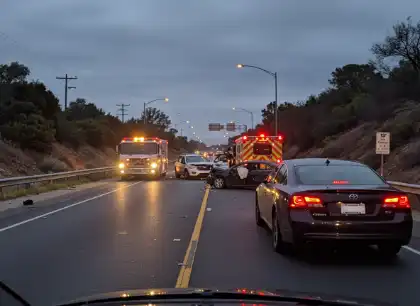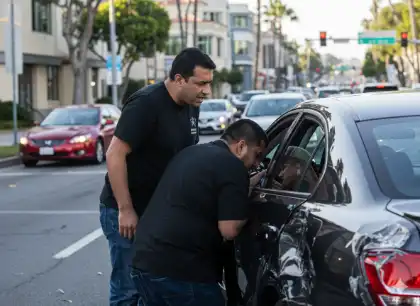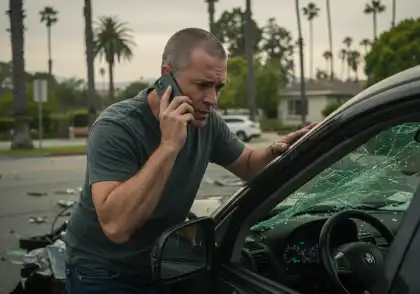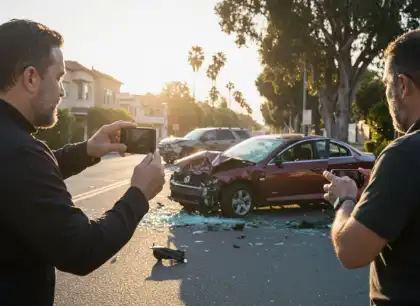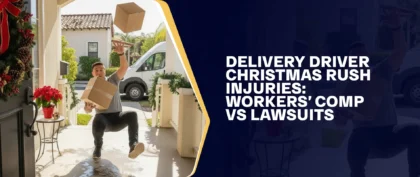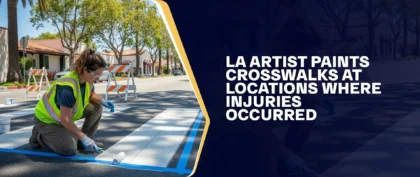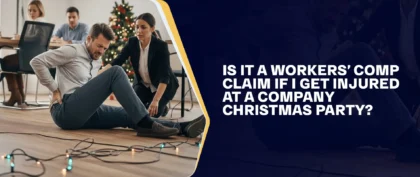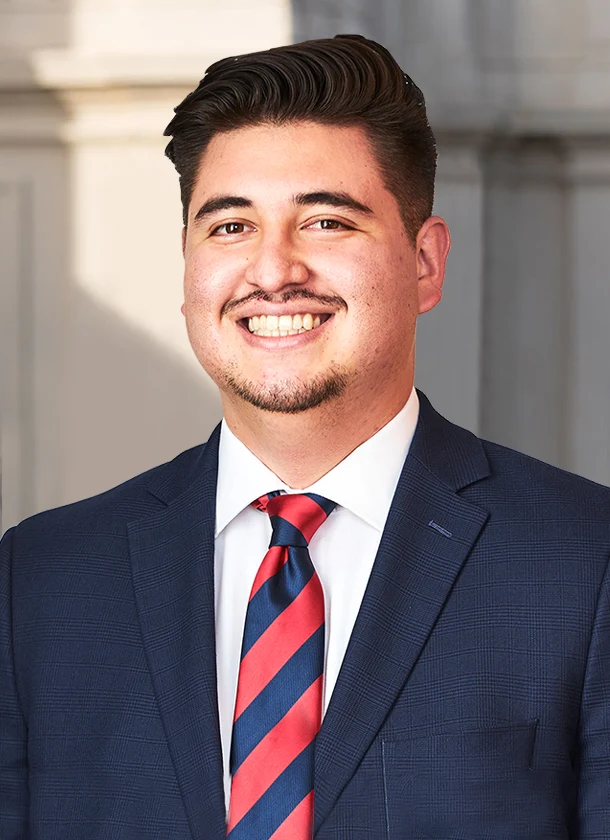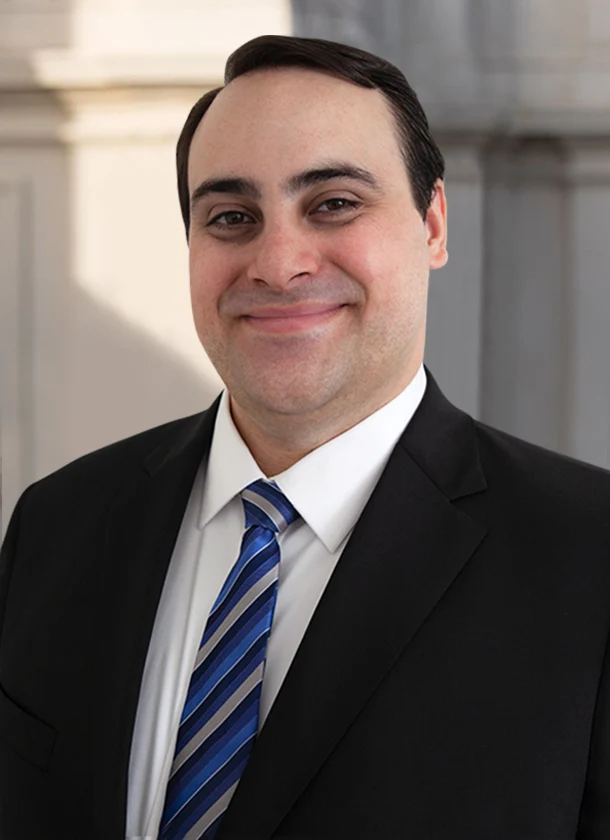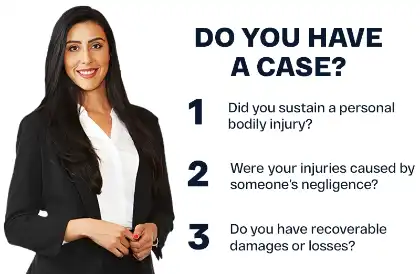TL;DR: When approaching an accident scene in California, first park at a safe distance, turn on hazard lights, and call 911. Comfort victims, but do not move them unless danger is present. Document the scene for the police and the victims. Call Arash Law at (888) 488-1391 for free legal help.
Table of Contents
When you approach an accident scene in California, your first step is to protect yourself and others by parking safely, making the scene visible, and calling 911. Acting quickly reduces the risk of secondary crashes and ensures first responders have accurate details to work with.
Bystanders are not legally required to help, but even simple actions like documenting the scene or offering calm reassurance can make a significant difference for injured people. California’s Good Samaritan Law also shields those who help in good faith from most liability.
Drivers, passengers, and pedestrians all face serious risks after collisions, especially in high-traffic areas where fuel leaks, fires, or blocked lanes add to the danger. Witnesses who act carefully can preserve valuable evidence for victims pursuing insurance claims or legal action.
Quick steps to remember:
- Park at a safe distance before approaching an accident scene.
- Turn on hazard lights and use warning triangles if available.
- Call 911 with details on location, vehicles, injuries, and hazards.
- Comfort victims without moving them unless they face immediate danger.
- Document the scene to support police and insurance claims.
The following steps explain how to approach safely, signal the scene, and provide meaningful support until professionals arrive.
Steps To Take When You Approach An Accident Scene
Car accidents create chaos in seconds. Injuries, blocked traffic, and dangerous conditions like fuel leaks or fire risks often follow. First responders may take several minutes to arrive, and those minutes can be critical.
As a bystander, you might not be legally obligated to step in, but your decision to act responsibly can:
- Prevent secondary accidents by signaling other drivers.
- Provide victims with reassurance and comfort.
- Help authorities later by providing witness statements and documentation.
Even simple actions can have a meaningful impact. Below are recommended steps to follow if you ever encounter a crash:
Step 1: Approach With Caution
Your safety comes first. Never rush directly into the crash site. Instead:
- Pull Over Carefully — Park at least 100 feet away from the scene. This distance gives space for emergency vehicles to reach the crash area.
- Stay Alert — Scan for hazards such as leaking gas, flames, broken glass, or traffic that hasn’t stopped yet.
- Do Not Create More Danger — Make sure your car is secure and parked off the street.
Tip: Keep reflective triangles or emergency lights in your car. These are valuable for alerting drivers on freeways or at night.
Step 2: Signal The Accident Scene
Once you’ve parked your car, focus on making the site visible. Accident scenes can quickly lead to secondary crashes. By signaling, you help protect both the victims and approaching motorists.
You can help reduce the risk of another crash by doing the following:
- Switch on your hazard lights.
- Set up warning triangles or cones (if you have them).
- Use a flashlight or wave cautiously to alert other drivers when visibility is low.
Your goal is to make the scene visible from a distance so other motorists slow down in time.
Step 3: Call 911
Do not assume someone else has already called. The sooner help arrives, the better for everyone involved.
When speaking to the dispatcher, provide the following:
- Exact Location — Include street names, intersections, or landmarks.
- Number of Vehicles — Tell them how many cars, trucks, or motorcycles are involved.
- Injuries — Share how many people appear hurt and whether anyone is unconscious.
- Hazards — Report issues like fuel spills, fire, blocked traffic, or downed power lines.
Stay on the line until the dispatcher ends the call. If another bystander is available, one of you can handle the call while the other continues securing the area.
Step 4: Help Victims With Caution
While waiting for first responders:
- Do not move victims unless they are in immediate danger (fire, explosion risk). Spinal, head, or internal injuries can worsen if they are moved unnecessarily.
- If safe, turn off vehicle ignitions to reduce the risk of fire-related injuries.
- Offer reassurance and let victims know help is coming.
- Use first aid only if trained and avoid making injuries worse.
This advice is especially important in cases involving catastrophic injuries, such as spinal cord injuries, brain injuries, amputations, or burn injuries, where moving someone incorrectly could make recovery harder. If you are not trained in first aid, remaining calm and supportive is still valuable.
Step 5: Document The Scene
Your documentation can help victims later with insurance and legal claims, but it should always stay private and be shared only with the right parties:
- Take photos or short videos of vehicles, damage, and skid marks.
- Record road conditions, traffic signals, and weather.
- Write down observations such as speeding or distracted driving.
- Do not post images or videos on social media. Sharing accident footage online can violate victims’ privacy, interfere with investigations, and even expose you to legal issues.
Sharing your documentation directly with police or victims is the safest and most helpful way to support the legal process. For instance, in speeding-related accidents, your statement could help authorities determine whether speed was a contributing factor to the collision. If the victims plan to pursue a claim, their accident lawyers can use your statement as evidence.
Step 6: Provide A Witness Statement
When the police arrive, they might ask what you saw. Focus on facts, not opinions. Don’t speculate about who was at fault. Instead, share details like:
- The direction in which each car was traveling.
- What you heard (e.g., screeching brakes, horn).
- Any unusual behavior, such as a driver running a red light.
You can also choose not to provide a statement. However, if you do provide one, your testimony may help victims establish fault. It can aid them as they pursue compensation for their losses.
Legal Duties And Protections In California
Unlike some states, California does not require bystanders to assist accident victims. You will not face penalties for choosing not to get involved.
California’s Good Samaritan Law encourages voluntary help by protecting individuals who act in good faith during emergencies from civil liability, provided their actions are reasonable.
You are generally protected if you:
- Act reasonably given the situation.
- Help in good faith, without self-serving motives.
- Do not expect compensation for your actions.
You are not protected if you:
- Act with gross negligence or reckless disregard for safety.
- Assist while under the influence of drugs or alcohol.
- Demand payment for helping.
This law exists to encourage compassion and safe intervention without fear of lawsuits. Still, it is important to act carefully. By understanding the Good Samaritan Law, you can step in responsibly, provide meaningful help, and avoid putting yourself or others at greater risk.
Special Situations You May Encounter
Not all crashes look the same. The steps you take when approaching an accident scene can vary depending on the type of collision and its risks.
- Truck Accidents — Larger vehicles may block multiple lanes, and debris can spread across highways. Extra caution is needed in these situations, which often lead to complex claims involving truck accidents.
- Motorcycle Accidents — Riders may suffer severe injuries that aren’t immediately visible. Crashes involving motorcycle accidents require careful documentation to help determine fault.
- Pedestrian Crashes — People struck while walking are left vulnerable in the roadway, making it vital to secure the area quickly. Injuries from pedestrian accidents can be especially serious, so stabilizing the scene is crucial.
- Freeway Accidents — High-speed traffic makes secondary crashes more likely. If you come across a freeway accident, make the scene visible from a distance and stay behind barriers whenever possible.
Each of these situations calls for calm, careful action. By staying alert and adjusting your response, you can help keep everyone safer until first responders arrive.
FAQs About Approaching Accident Scenes In California
It’s normal to have questions about what you should and shouldn’t do if you come across a crash. Below are some common questions and answers to help you understand how to approach an accident scene.
If you have specific legal questions after an accident, you may contact Arash Law for guidance.
What Should You Do When Approaching An Accident Scene?
Coming across a collision can be unsettling, but the right response keeps you and others safe. Instead of rushing in, take deliberate steps that make a difference while waiting for professionals to arrive.
Here’s what you can do:
- Stop Safely — Park at a safe distance so emergency crews can reach the area.
- Make The Scene Visible — Switch on hazard lights and set up warning triangles if possible.
- Call For Help — Dial 911 and give precise details about the crash, including location, number of vehicles, and visible injuries.
- Support Carefully — Speak calmly to injured people, but avoid moving them unless danger is immediate.
- Preserve Evidence — Take photos and notes to help authorities and victims later.
Even small actions matter. By calling for help or simply reassuring someone, you can give victims much-needed support until first responders arrive. The evidence you gathered can also help collision lawyers build a case for the victims if they choose to pursue a claim.
How Is Fault Determined In A Car Accident In California?
California follows a pure comparative negligence system. This tort principle means each driver can be assigned a percentage of fault. For example, if one driver is found 70% responsible and the other 30%, any compensation is adjusted to reflect those percentages.
Understanding how a fault is determined can be stressful, especially when you are recovering from injuries. That’s why many people choose to speak with a car accident lawyer who can review the evidence, explain their options, and guide them through the process.
Do I Have To Report Accidents I Witness?
If you only witness an accident in California, you are not legally required to report it. You can choose to call 911 if emergency responders have not yet been contacted, but the law does not obligate you to file a report.
However, if you are involved in the crash, even if you were not at fault, you must report it to the DMV within 10 days if it resulted in:
- Injury to anyone
- Death
- Property damage of more than $1,000
This requirement is separate from a police report. Even if officers arrive at the scene and file their own report, you are still responsible for submitting the SR-1 accident report form to the DMV. Failure to do so may lead to fines or suspension of your driver’s license.
Can A Bystander Be Liable For Helping In An Emergency?
In California, bystanders who try to help in good faith are generally not held liable if their actions are reasonable. The Good Samaritan Law protects people who provide aid without expecting payment, as long as they act responsibly and are not reckless or under the influence. This protection encourages bystanders to step in when safe, giving victims comfort and support until professionals arrive.
Get Legal Guidance After A Car Accident
While you don’t have to step in at an accident scene, choosing to act with care may greatly improve someone’s outcome. First responders might take some time to arrive, so if you decide to approach and help, do so cautiously.
Once the emergency is managed, victims could face medical bills, time off work, and legal issues. Your testimony and documentation could be very helpful to them.
If you or someone you know has been injured in a California accident, speaking with an injury lawyer can help clarify options. Call Arash Law at (888) 488-1391 for a free initial consultation, or complete our “Do I Have A Case?” form online, here.

